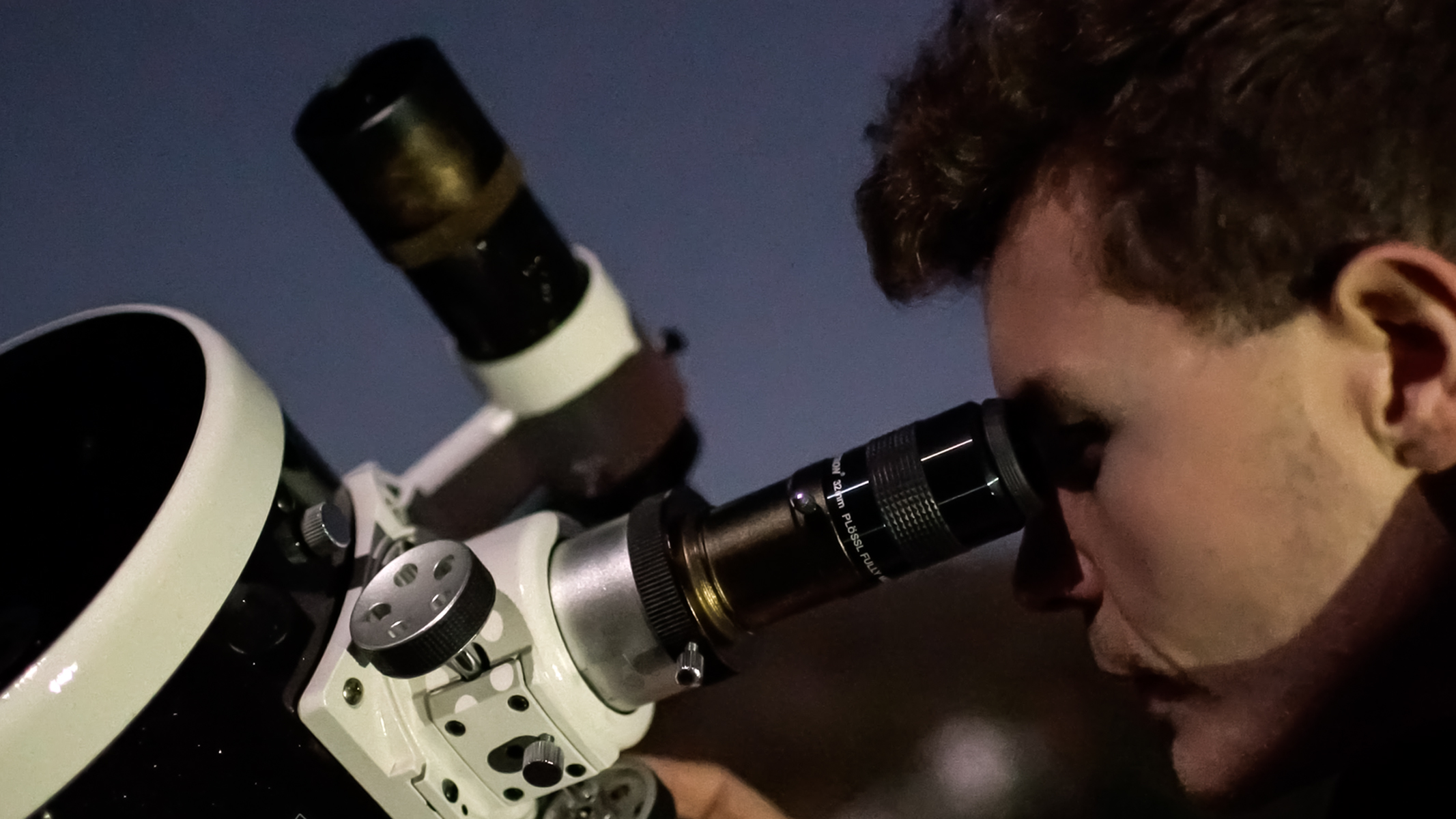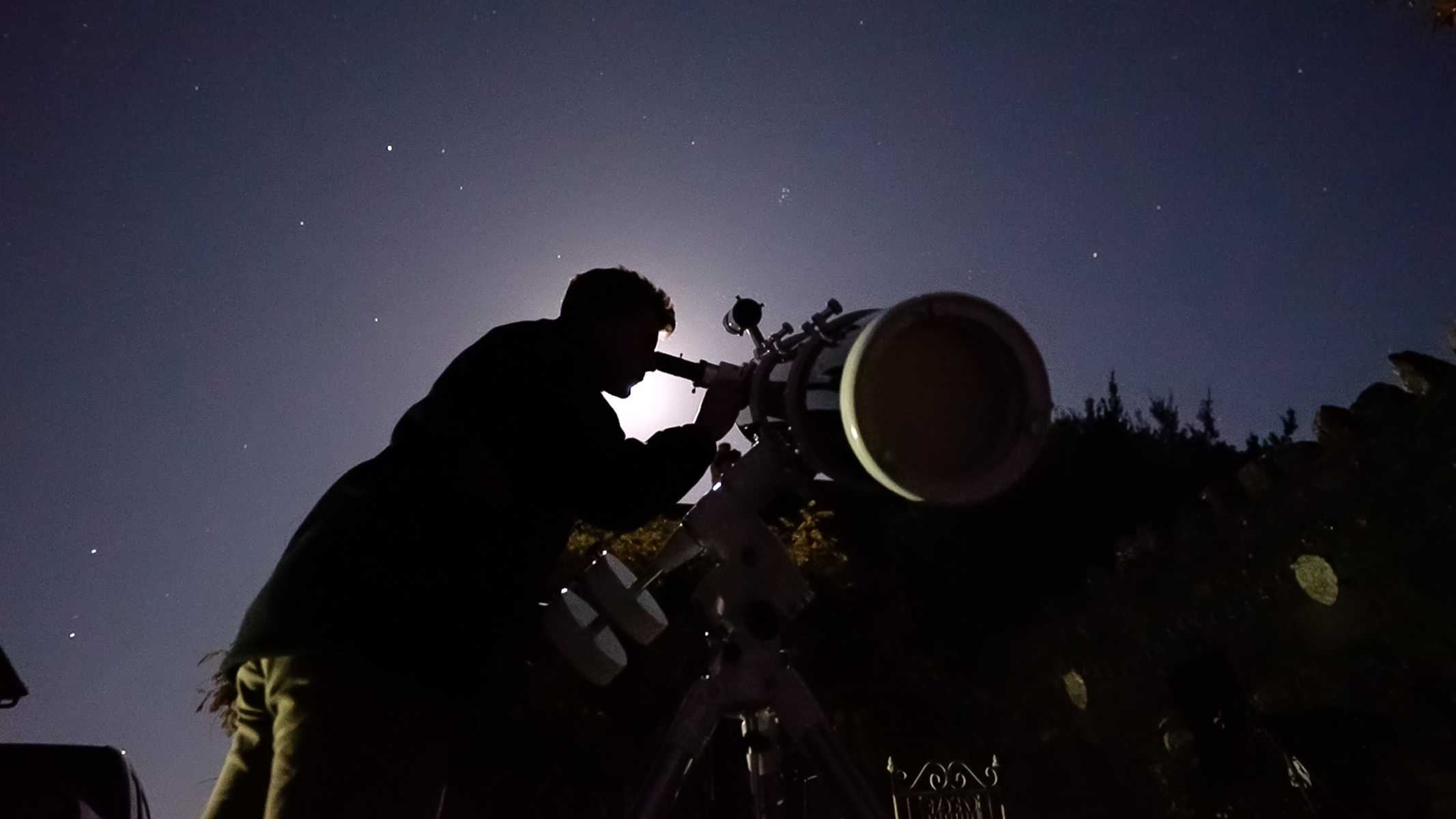Space Verdict
Overall, the Sky-Watcher 200P EQ5 is a commendable telescope for anyone wishing to pursue their journey to the cosmos or looking for an affordable, more advanced piece of equipment.
Pros
- +
Affordable price range
- +
More advanced equipment
- +
Greater light gathering
Cons
- -
Heavier equipment setup
- -
More moveable components
- -
RA and DEC Motors are sold separately
Why you can trust Space.com
The Sky-Watcher 200P EQ5 telescope is an impressive optical instrument. In terms of budget and optical build, this telescope provides sharp, contrasted details of our open window to the universe. Being 'the next step-up,' this telescope requires more astronomical knowledge from conventional 'go-to' telescopes due to the equatorial mount which involves knowledge of right-ascension and declination.
This telescope is recommended for anyone wishing to get a closer view of the universe within the affordable price range. With quality optics, expect to see quality views of the planets, deep-sky objects and celestial visitors. For this review, the 8-inch version with the EQ5 mount was tested.
Sky-Watcher 200P 8-inch EQ5 telescope review
Sky-Watcher 200P 8-inch EQ5: Design

- Very sturdy equatorial mount
- 77% more Light Gathering compared to the 6-inch (150mm) counterpart
- Heavy, so not great for portability
Optical design: Newtonian Reflector
Mount: EQ5 Equatorial German Mount
Focal length: 1000mm
Aperture: 8-inches (203.2mm)
Payload capacity: 20 lb (9.07 kg)
Weight and size
The 200P EQ5 is a respectable, rock-solid telescope setup. With an overall shipping weight of 55 lb, the two counterweights come in at 11 lbs each, and the Optical Tube Assembly (OTA) measures in at 19 lb. When set up, the tripod measures between 71 and 123 cm.
As this model is the next step up from the 150mm equivalent, heavier counterweights are needed to cater to a great payload capacity. Therefore, a more robust tripod mount is required. When setting up this tripod, we recommend installing the assembly in smaller parts rather than moving the whole unit together due to its overall weight. This is especially true if used in a permanent installation such as a home observatory. However, a good method for aligning the tripod feet would be to use markers for polar-alignment purposes, if re-assembly before observation is required.
Optics
The Optical Tube Assembly (OTA) measures a 1000mm (f/5) focal length and 200mm primary mirror diameter. Its design is recognized as a 'fast' telescope because of its light-gathering capabilities, allowing for 77% more light gathering compared to its 150 mm counterpart. This is ideal for resolving finer details, especially for more detailed observations of the Moon, planets, galaxies, and nebulas.
Breaking space news, the latest updates on rocket launches, skywatching events and more!
The Sky-Watcher 200P EQ5 caters to 0.5 mm ultra-thin secondary mirror supports to prevent both distortions to visual observation and astrophotography. The mirrors are 'parabolized' to bring all the light rays to the same focal point, providing sharp, contrasted images. This setup also comes with a Dual-Fit 1.25/2 -inch focuser, allowing both 1.25/2 -inch eyepieces to be used. Eyepieces supplied with this telescope range from 10mm and 25mm, reaching a potential of x400 magnification.
Supplied is a 9 x 50 Crosshair Finderscope which can be simply aligned using fine adjustment knobs for locating celestial objects. Right-ascension and declination adjustment locks prevent the telescope from 'slewing' and can be simply unlocked by twisting the adjustment lock.
Equatorial Mount
The very sturdy EQ5 Equatorial mount provides excellent precision and stability and a host of other useful features. The EQ5 mount rests firmly on a large, adjustable stainless steel pipe tripod with the included accessory tray to support the structure of the tripod mount. Supplied complete with a bubble level, latitude adjuster with micrometer-scale and an azimuth polar-alignment adjuster. It also features engraved aluminum setting circles and manual slow-motion tracking controls to keep your celestial target within view. An optional polar scope is available for aiding in polar alignment. Optional single-axis and dual-axis D.C. motor drives can be easily installed for auto-tracking purposes to track celestial objects for a greater period of time.
Sky-Watcher 200P 8-inch EQ5: Performance

- Requires collimation on both primary and secondary mirrors
- Polar alignment is simple and works well
- Resolving power is good for resolving details on planets
Collimation
Using a Newtonian-Reflector build, this telescope requires you to collimate (align) both the primary and secondary mirrors. The primary mirror highlights a small collimating circle, and alignment is achieved using a laser collimating eyepiece (sold separately). When operated, a laser is used to align its position on the mirror to the collimating circle using and reflecting the laser to a target in the laser collimating eyepiece.
We found that the position of both the primary and secondary mirror can be adjusted using locking knob adjustment screws (on the primary mirror) and thread screws on the secondary mirror. Align the primary mirror first and the second after. It is a more timely process as we have found this build tends to misalign if moved or disassembled. Alignment is recommended prior to each observation so might be frustrating for those new to observing or who have limited time to set up telescopes such as this.
Polar Alignment
When using the Sky-Watcher 200P telescope we found the polar alignment worked very well with the EQ5 providing a simpler approach to aligning our telescope. The model tested included a built-in polar alignment telescope that projects an image of the recognized circumpolar constellations (for the northern hemisphere, Ursa Major and Cassiopeia, and Crux for the Southern Hemisphere).
Knowing our latitude (which can be located, using an app such as Google Maps), we adjust the latitude using the twist-adjustment and fine adjustment knobs on the telescope to match the position of the north celestial pole.
Adjusting the position of our telescope, the concept is then to match the current position of the constellations allowing for simple adjustment to align with the North Star, Polaris (as viewed in the polar alignment telescope). Once Polaris is in view, the telescope setup is aligned to the north celestial pole, and if using Right-Ascension (R.A.) and Declination (DEC.) motors, these can now be operated to track celestial objects.
Resolving Power
The resolving power of this telescope was rated as good. With a potential to reach magnifications of up to x400 magnification, it was possible to reveal details, including the Great Red Spot on Jupiter, as well as weather systems, including the Galilean Moons.
We found during testing that depending on the turbulence in the Earth's atmosphere, it is possible to distinguish the Cassini Division on Saturn as well as the A and B rings, alongside brighter moons, including Titan. Mars was a personal favorite for this review; during its recent opposition, to observe the polar ice caps as well as darker surface details, including Syrtis Major.
Using a wider eyepiece, this telescope is favorable for deep-sky targets, although it is worth mentioning the Field Of View is smaller for The Andromeda Galaxy (M31). As with all telescope designs, a night free from turbulence is required to resolve these finer details; colder nights typically provide clearer views, the EQ5 being no exception in withstanding colder environments.
Sky-Watcher 200P 8-inch EQ5: Functionality

- Susceptible to accumulating dust
- Some targets are hard to observe and require meridian flip
- Can take more time to distribute weight effectively
Clean optics
Because this telescope has a wider opening and exposes both the primary and secondary mirror, this telescope build is more susceptible to accumilate dust and debris over time. It is recommended to keep the telescope using the appropriate covers supplied. However, it may be appropriate at times to clean your telescope mirror, which needs to be hazarded with a word of caution, to follow strict instructions to preserve the parabolized optical coatings on your mirrors. The best solution is to use distilled water and a microfiber lens cloth to remove this residue and leave it to dry. Follow the instruction manual to prevent damage to your optics if purchasing this telescope.
Weight distribution
When considering a reflector telescope and equatorial mount such as these, there are a number of elements to consider when weighing up the odds. Setting up this type of telescope can take more time to appropriately distribute the weight of the telescope tube and the provided counterweights. This prevents strain on tracking motors and any sudden movements during operation. Bringing the interface parallel is the easiest way to make minute adjustments to the counterweights and position of the optical tube. As mentioned earlier, some elements, including the counterweights, are heavy with this design, so be careful when attaching them to the fork arm of the equatorial mount and ensure they are fastened securely.
Meridian flip
A feature to note which is apparent with the design and build of this style of telescope is the consideration for a 'meridian flip'. Depending on the nature of the astronomical target intended to be observed, whether it be low on the horizon or vice versa, we found that the size of the optical tube may result in making contact with the mount. This makes it more difficult to observe some celestial targets until a meridian flip is performed.
Moving the telescope to its stationary or 'locked' position only requires the Optical Tube Assembly to be rotated 180-degrees. This resets the position of the OTA across the meridian, hence the term, 'meridian-flip'. Therefore, the Optical Tube Assembly may need to be rotated to bring the eyepiece into a more comfortable position, your celestial target re-aligned and observation may be continued.
Should I buy the Sky-Watcher 200P EQ5 telescope?
If you want a large but affordable telescope to provide highly detailed views of astronomical objects, this scope could be for you. The only reason we wouldn't recommend this scope is if you aren't confident in polar aligning processes, and have no desire to learn. It's probably not ideal for beginners due to the slightly more complicated set-up equatorial mount procedures, heavier counterweights and meridian-flip requirements in some observing situations.
While quite affordable, it's aimed at an intermediate market where beginner astronomers have learnt a good deal about the night sky and have the need to upgrade from their entry-level telescopes.
If the Sky-Watcher 200P EQ5 telescope isn't for you
Looking at some alternative options, the Celestron 8SE is a good all-rounder telescope. It's more expensive than the Sky-Watcher reviewed here but well worth the investment in terms of quality optics and its motorized mount with the built-in go-to option. At an 8-inch diameter, its light-gathering capabilities are a good all-rounder for the planets, Moon and deep-sky objects, and the catadioptric Schmidt-Cassegrain design keeps the telescope portable when using suitable travel carriers.
More advanced observers may opt for the Meade LX200 series. It's more versatile and operates in a similar way to the Celestron 8SE, with Meade's own built-in interface and an overall good competitive telescope. Sizes vary from 8, 10 to 12-inch builds and observers should take care if used for star parties due to its weight. A permanent observatory setup may be preferred.
For the more seasoned observer, the Sky-Watcher EQ5 200P is a suitable choice. Yes, it requires astronomical know-how of an equatorial mount, however, Sky-Watcher explains the differences very well when it comes to polar alignment and 'balancing' your telescopes counterweights, which can get you up and running in minutes. This therefore is a more affordable price range with quality optics and an ideal 1000mm focal length.

Josh Dury (B.A. FRAS) is an Award-Winning Landscape Astrophotographer, Presenter, Speaker and Writer based in Somerset, UK. His work has been recognized by NASA, Astronomy Picture Of The Day, BBC, CBS, and CNN, amongst others. With endorsements from Apollo 11 Astronaut Buzz Aldrin and ESA British Astronaut Tim Peake. His work has been recognised by major photographic and astronomical bodies, including The World at Night (TWAN), Astronomy Photographer of the Year, Historic Photographer of the Year and PetaPixel, whilst collaborating with photographic brands: Canon, Sigma, Benro, NiSi and Tenba. As a Delegate of The International Dark-Skies Association (IDA) he uses astrophotography as a platform, in raising awareness of dark-sky conservation and the impacts of light pollution to the natural environment.

